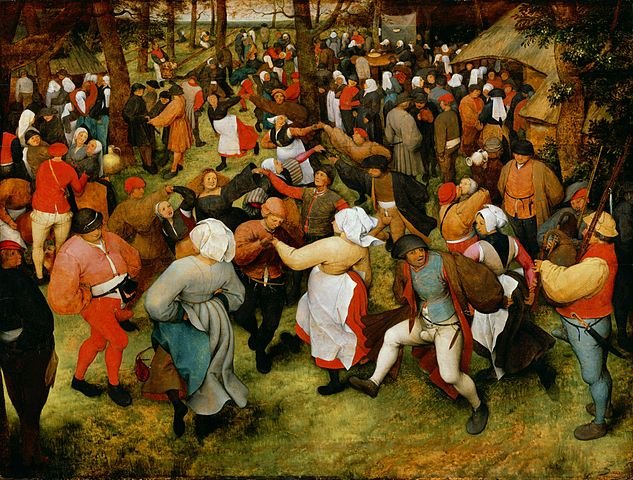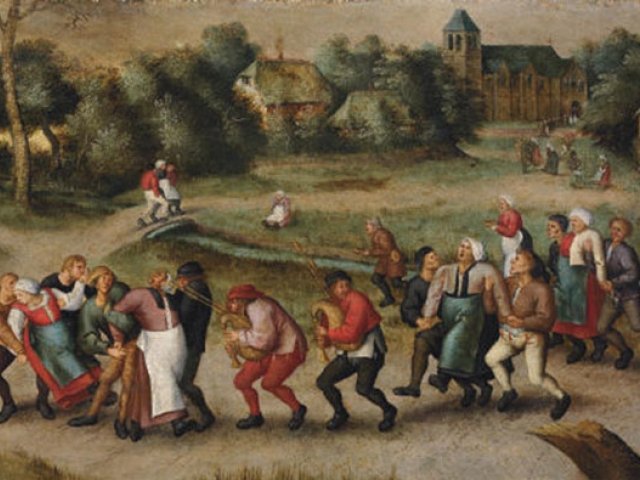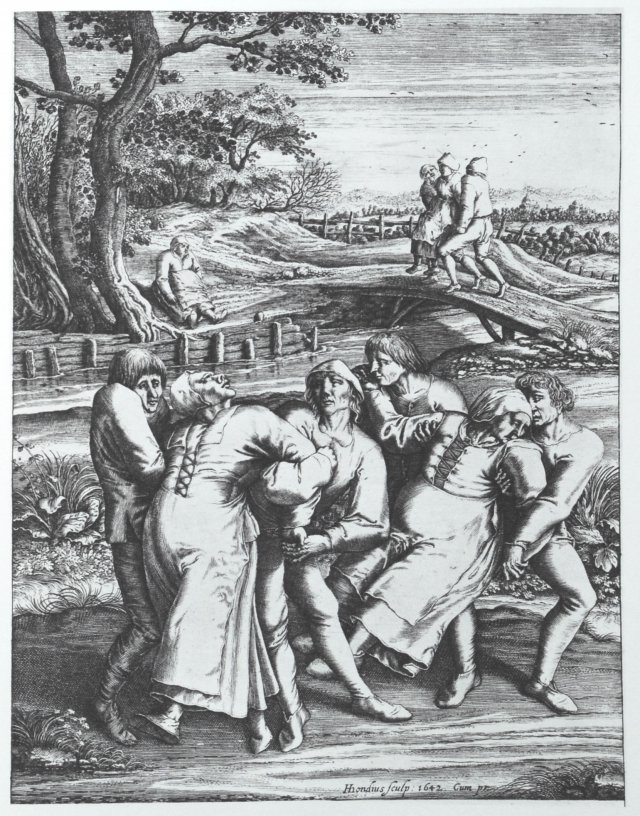Unexplained Phenomenon Of The Dancing Mania That Occurred During The Middle Ages
Ellen Lloyd – AncientPages.com - We live in a world full of mysteries. We often come across intriguing stories dealing with unexplained phenomena that make us even more curious about the realms we inhabit.
One such baffling event took place during the Medieval period in Europe.
In July of 1374 in Aachen, Germany, dozens of villages along the Rhine River were suddenly swept by a dancing plague called choreomania. For no apparent reason, hundreds of people took to the streets, leaping, jerking, and hopping to music.
The strange thing was that no-one else could hear the music except those who danced. How was it possible?
Another odd aspect of this story is that these people didn't want to stop dancing.
They did eat, drink or sleep. All they did was dance, shout, and hallucinate for days.
Sometimes, even when they fell, they continued to dance while on the ground. Obviously, they couldn't control their movements until finally, their weakened bodies collapsed from exhaustion.
This outbreak of dancing mania spread as far as France and lasted for several years. Almost just as suddenly as it had come, it disappeared.
This would be the end of this story, but something similar occurred in Strasbourg, France, back in 1518. A woman named Frau Troffea suddenly started to dance nonstop for days. Within a week, she was joined by 34 people and by the end of the month, the dancing plague had affected an estimated 400 people. Once again, people "danced themselves to death" for no obvious reason.
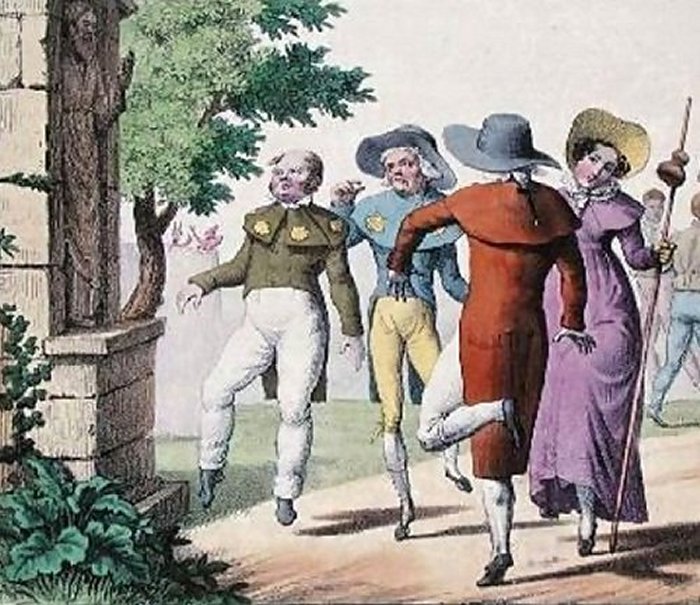
Dancing mania, also sometimes known as St. Vitus' dance, was first recorded in the 7th century and reappeared many times across Europe until about the 17th century.
It remains unknown what exactly caused the outbreaks of dancing mania. Some scientists have suggested the cause was mass hysteria. Other researchers explain this odd behavior as a mass psychogenic illness, which is a form of mass hysteria. This happens when a group of people mistakenly believe that they are afflicted with a common disease. Yet another possible explanation is ergot poisoning. Ergotism is contracted from a fungus that can grow on many grains, such as corn and rye. The symptoms of ergotism are very similar to those of dancing mania. It is possible that this fungus-infected food supplies of the afflicted areas.
Historian John Waller, author of the book "A Time to Dance, A Time to Die: The Extraordinary Story of the Dancing Plague of 1518," studied the illness at length and has solved the mystery. "That the event took place is undisputed," said Waller, a Michigan State University professor who has also authored a paper on the topic, which has been accepted for publication in the journal Endeavour.
Waller explained that historical records documenting the dancing deaths, such as physician notes, cathedral sermons, local and regional chronicles, and even notes issued by the Strasbourg city council during the height of the boogying rage, all "are unambiguous on the fact that (victims) danced."
"These people were not just trembling, shaking or convulsing; although they were entranced, their arms and legs were moving as if they were purposefully dancing," he said.
Waller suggested that stress-induced psychosis was behind the dancing mania that struck Medieval Europe. In those days, people suffered from famine, and many died of starvation. The area was riddled with diseases, including smallpox and syphilis. Waller believes the stress was intolerable, and hence a mass psychological illness resulted.
Waller also points out that superstition was widespread among the people. "Anxiety and false fears gripped the region," Waller said.
One of these fears, originating from a Christian church legend, was that if anyone provoked the wrath of Saint Vitus, a Sicilian martyred in 303 A.D., he would send down plagues of compulsive dancing.
The school was forced to shut down after more than half the students - 95 out of 159, were affected. Ten days after the school was closed, the plague struck a village 55 miles away and affected 217 for two months. The epidemic also spread through the countryside.
Such epidemics occurred in ancient times and can still happen today. As we have seen, there are several theories attempting to solve these mysterious outbreaks. Scientists may never be able to figure out precisely what caused the dancing mania outbreaks in medieval Europe.
The laughing epidemic in Tanzania requires further study and could solve the mystery of medieval dancing mania. Scientists believe that "in order to interpret this behavior as normal or pathological, a study of the cultural context should be made."
Again, perhaps we shouldn't compare ancient and modern outbreaks because they can have entirely different causes. In any case, despite the proposed theories, it appears that the Medieval Dancing Mania will remain an unexplained phenomenon that we will never be able to understand truly.
Written by - Ellen Lloyd – AncientPages.com
Copyright © AncientPages.com All rights reserved. This material may not be published, broadcast, rewritten or redistributed in whole or part without the express written permission of AncientPages.com
More From Ancient Pages
-
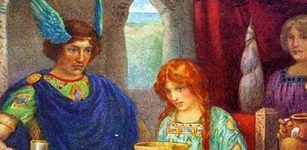 Skirnir’s Mission To Jotunheim To Gain Gerda For Lovesick God Frey
Featured Stories | Mar 14, 2020
Skirnir’s Mission To Jotunheim To Gain Gerda For Lovesick God Frey
Featured Stories | Mar 14, 2020 -
 The Untold Story Of The Inca – Fire In The Sky – Part 1
Civilizations | Jul 2, 2019
The Untold Story Of The Inca – Fire In The Sky – Part 1
Civilizations | Jul 2, 2019 -
 Cuicuilco Circular Pyramid: Ancient Astronomical Observatory And Place Of Power
Civilizations | Aug 24, 2021
Cuicuilco Circular Pyramid: Ancient Astronomical Observatory And Place Of Power
Civilizations | Aug 24, 2021 -
 Andvaranaut: Magical Ring That Made Gold And Was Stolen By Norse God Loki
Featured Stories | Apr 12, 2017
Andvaranaut: Magical Ring That Made Gold And Was Stolen By Norse God Loki
Featured Stories | Apr 12, 2017 -
 Who Made The Mysterious Ancient Cave Paintings And Inscriptions In Oklahoma 2,500 Years Ago?
Featured Stories | Jul 23, 2024
Who Made The Mysterious Ancient Cave Paintings And Inscriptions In Oklahoma 2,500 Years Ago?
Featured Stories | Jul 23, 2024 -
 Mystery Of Ancient, Overlooked Calico: Early Man Site In The Mojave Desert Of North America
Civilizations | Sep 9, 2021
Mystery Of Ancient, Overlooked Calico: Early Man Site In The Mojave Desert Of North America
Civilizations | Sep 9, 2021 -
 2,000-Year-Old Ruins In Mary Magdalene’s Town Of Magdala On The Shore Of The Sea Of Galilee
Biblical Mysteries | Dec 26, 2014
2,000-Year-Old Ruins In Mary Magdalene’s Town Of Magdala On The Shore Of The Sea Of Galilee
Biblical Mysteries | Dec 26, 2014 -
 What Can Monument 9 Reveal About The Mysterious Olmec Civilization?
Featured Stories | Jun 30, 2023
What Can Monument 9 Reveal About The Mysterious Olmec Civilization?
Featured Stories | Jun 30, 2023 -
 Day Of The Dead: From Aztec Goddess Worship To Modern Mexican Celebration
Ancient Traditions And Customs | Oct 30, 2019
Day Of The Dead: From Aztec Goddess Worship To Modern Mexican Celebration
Ancient Traditions And Customs | Oct 30, 2019 -
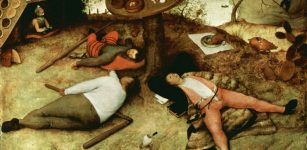 Medieval Paradise Cockaigne – Land Of Extreme Pleasure And Luxury
Featured Stories | Dec 12, 2018
Medieval Paradise Cockaigne – Land Of Extreme Pleasure And Luxury
Featured Stories | Dec 12, 2018 -
 Walls Of Lugo: Finest Example Of Late Roman Fortifications – Stands The Test Of Time
Featured Stories | Sep 22, 2022
Walls Of Lugo: Finest Example Of Late Roman Fortifications – Stands The Test Of Time
Featured Stories | Sep 22, 2022 -
 The Mysterious Books Of Prophecies Of The Knights Templar – Where Are They Hidden?
Featured Stories | Mar 26, 2022
The Mysterious Books Of Prophecies Of The Knights Templar – Where Are They Hidden?
Featured Stories | Mar 26, 2022 -
 Riddle Of The Ancient Sarcophagus And Its Strange Properties – Can Science Solve This Mystery?
Featured Stories | Nov 7, 2019
Riddle Of The Ancient Sarcophagus And Its Strange Properties – Can Science Solve This Mystery?
Featured Stories | Nov 7, 2019 -
 Teotihuacán: Enigmatic Birthplace Of The Gods And Its Obscure History
Civilizations | Jul 26, 2016
Teotihuacán: Enigmatic Birthplace Of The Gods And Its Obscure History
Civilizations | Jul 26, 2016 -
 The Controversial History Of Moses – Who Was He Really?
Biblical Mysteries | Sep 13, 2015
The Controversial History Of Moses – Who Was He Really?
Biblical Mysteries | Sep 13, 2015 -
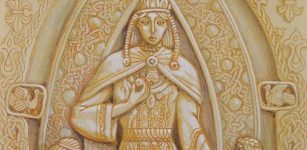 Lada: Jump Over Fire For Goddess Of Beauty, Love, And Marriage In Slavic Mythology
Featured Stories | Dec 11, 2017
Lada: Jump Over Fire For Goddess Of Beauty, Love, And Marriage In Slavic Mythology
Featured Stories | Dec 11, 2017 -
 Curious Alien-Looking Slit Gongs Figures From Vanuatu Allowed Villagers To Communicate
Ancient Traditions And Customs | Sep 24, 2018
Curious Alien-Looking Slit Gongs Figures From Vanuatu Allowed Villagers To Communicate
Ancient Traditions And Customs | Sep 24, 2018 -
 10 Spooky Ancient Places That Are Home To The Feared Living Dead
Featured Stories | Oct 31, 2020
10 Spooky Ancient Places That Are Home To The Feared Living Dead
Featured Stories | Oct 31, 2020 -
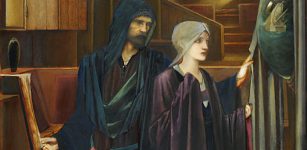 Michael Scott – Fascinating Wizard Who Tutored The Holy Roman Emperor Frederick II
Featured Stories | Jun 12, 2024
Michael Scott – Fascinating Wizard Who Tutored The Holy Roman Emperor Frederick II
Featured Stories | Jun 12, 2024 -
 Goblins: Antisocial, Grotesque, Ugly And Vengeful Fairy Creatures In Ancient Beliefs
Featured Stories | Dec 6, 2018
Goblins: Antisocial, Grotesque, Ugly And Vengeful Fairy Creatures In Ancient Beliefs
Featured Stories | Dec 6, 2018

